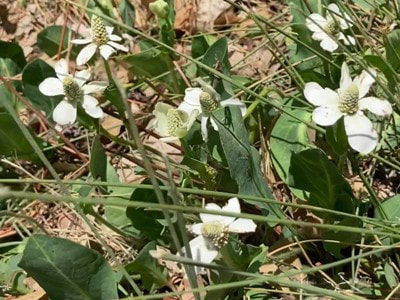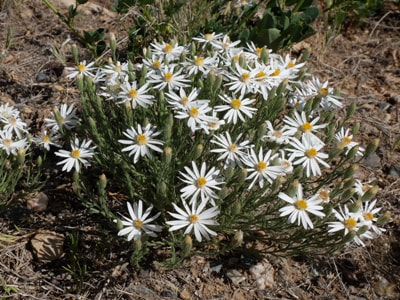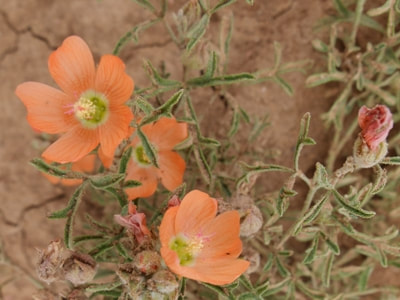Yerba Mansa, Lizard's Tail, Yerba del Manso,Anemopsis Californica,Lizard Tail Family (Saururaceae)6/12/2020 Found in wet alkaline or saline soil
Seen blooming in June by CR 56 in Ohkay Owingeh Yerba Mansa grows to 12 inches high with waxy, mostly basal leaves which form a dense ground cover. Flower heads are a fragrant, showy, cone-shaped spike over one inch long surrounded by four to nine white to reddish petal-like bracts. The spike consists of about 100 densely packed greenish flowers which have a small white bract but no petals. In the fall, the whole plant turns brick-red in color. Yerba Mansa is an important medicine plant used as a disinfectant, anti-bacterial, anti-fungal and a general anti-microbial. It is used as a treatment for wounds, cold and flu symptoms, pain and inflammation, as well as lung, circulatory, urinary, and digestive tract ailments. Tea made from the leaves and roots is used to treat uterine cancer, ease menstrual cramps, induce conception, staunch excessive bleeding after childbirth and as a treatment for other gynecological conditions, and to treat venereal sores and ulcers. Source. If you trying to identify a different flower then you can check what other flowers bloom this month. If you cannot identify a flower from the website send a photo and where you took it to contact@rockymountainsflora.com. Read online for tips.
0 Comments
Rose Heath, Baby White, Baby Aster, Sand Aster,Chaetopappa ericoides,Sunflower Family (Asteraceae)6/3/2020 Found in dry open areas, roadsides
Seen blooming in June by the road to Abiquiu Lake The Rose Heath is neither a rose nor a heath. Its dainty white flowers look like daisies but are not daisies, although in the same family. It grows in groups of plants to 6 inches high with many slender stems, often forming a compact mound. The simple narrow leaves are heath-like and hairy. Its petals curl under in the evening and after rain. Native Americans found a variety of medicinal uses for the petite Rose Heath. The Havasupai used it as a gastrointestinal aid, the Hopi used it to aid ‘a sore nose’, as a panacea, a sedative, a stimulant and for determining the sex of a baby, the Navajo used it for kidney and bladder disease, and as a toothache and snakebite remedy and the Zuni used it as a cold remedy and for swelling and rheumatic pain. Source. If you trying to identify a different flower then you can check what other flowers bloom this month. If you cannot identify a flower from the website send a photo and where you took it to contact@rockymountainsflora.com. Read online for tips. Scarlet Beeblossom, Scarlet Gaura, Scarlet Evening Primrose, Linda Tarde,Oenothera suffrutescens,5/29/2020 Evening Primrose Family (Onagreaceae)
Found in dry open areas, roadsides Seen blooming in May in Abiquiu Airy and delicate in appearance, Scarlet Beeblossom grows to 1½ feet tall and wide with thin branches from the base. It can form large colonies in disturbed areas and is considered a noxious weed in California. Leaves are narrow and grow close to the branches. The flowers are about ½ inch across and grow in a long cluster, often nodding at the tip. Flowers have four spoon-shaped petals which are initially white, becoming pink then red as they mature and wither. Eight long white stamens are tipped with red anthers. It is not toxic or strongly medicinal. The Navajo made a cold infusion (tea) for children to settle their stomachs after vomiting. The Lakota rubbed it on their hands to catch horses, apparently horses were curious about the smell so let people get close. Source. If you trying to identify a different flower then you can check what other flowers bloom this month. If you cannot identify a flower from the website send a photo and where you took it to contact@rockymountainsflora.com. Read online for tips. Found in dry areas, canyons, hillsides
Seen blooming in May in Red Wash Canyon For most of the year you will walk past this twiggy, unpretentious shrub but at this time of the year, when it is in bloom, it is very conspicuous. It grows to about three feet tall with blue green to olive green branches and twigs growing at odd angles. Plants are either male or female and produce cones for reproduction rather than flowers. The photo is of the bright yellow, pollen-producing male. The species serves as food for wildlife and is eaten by livestock, especially sheep. This species of Ephedra has no ephedrine or pseudoephedrine and has no medicinal qualities; the commercial drug ephedrine comes from an Ephedra which grows in China or is produced synthetically. People of the Mormon faith brew a tea from these plants by steeping the stems in boiling water, giving it its common name. Source. If you trying to identify a different flower then you can check what other flowers bloom this month. If you cannot identify a flower from the website send a photo and where you took it to contact@rockymountainsflora.com. Read online for tips. Cowboy’s Delight, Scarlet Globemallow, Copper Mallow,Sphaeralcea coccinea,Mallow Family (Malvaceae)5/15/2020 Found in dry slopes, disturbed soil
Seen blooming in May by CR 142 This is one of six species of Globemallow that grow in our area and is the earliest bloomer. Also coming into bloom now is the Small-leaf Globemallow which is taller and has triangular leaves. Scarlet Globemallow grows from 4" to 16" in large patches, usually about 8" high. Leaves are deeply divided into three or five then divided again and can appear grayish-green from the fine silvery hairs that cover them. Sometimes the edges fold in making them appear even narrower. Flowers grow in a dense cluster at the end of the branches and have five orange petals forming a cup or saucer shape. The fruit produced is shaped like a cheese-wheel and splits apart into segments like an orange. Its common name of Cowboy’s Delight is said to come from the delight its bright colors gave to a cowboy in a dull, arid landscape. The Teton Sioux used it ceremonially. A paste was used as a cooling agent for burns, scalds, and sores. A tea was used as a lotion for skin diseases, and a tonic to improve appetite. The Navajo used a tea for improving the taste of bitter medicinal herbs. Crushed leaves were used as a poultice for skin irritations and as a shoe liner for blistered feet. Source. If you trying to identify a different flower then you can check what other flowers bloom this month. If you cannot identify a flower from the website send a photo and where you took it to contact@rockymountainsflora.com. Read online for tips. |
AuthorI am Marilyn Phillips, a native of England, whose love of nature and the outdoors from childhood brought me by a circuitous route to Crested Butte, Colorado in 1993 and 16 years later to northern New Mexico. My exploration of the many trails in these areas, my interest in wildflowers and photography, and career in computer system design came together in this creation. If you have any corrections, comments or questions, please contact me by email. Archives
September 2024
Categoriescopyright © 2020
|







 RSS Feed
RSS Feed